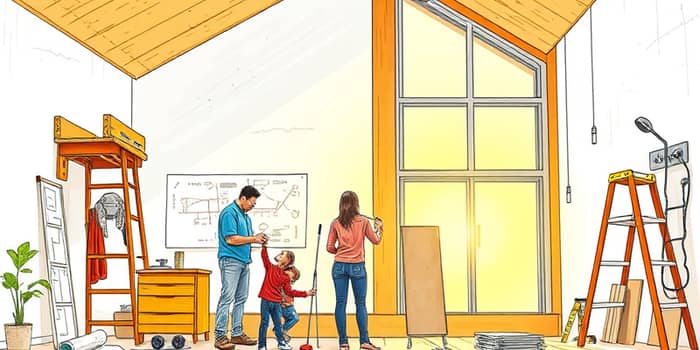
In 2025, the appetite for home renovation is stronger than ever. Homeowners are eager to transform their living spaces into modern, sustainable sanctuaries that reflect their personalities and values. However, turning renovation dreams into reality often requires access to capital that many families do not have readily available. This is where personal loans come into play, offering a streamlined path to financing home improvements that can add comfort, functionality, and value to your property.
Unlike traditional home equity products, personal loans offer flexibility and speed without the need for collateral. In a market that has grown at a CAGR of 6.5% in 2025, and with construction industry value up by 10%, the option to secure funds quickly has never been more appealing. By understanding the nuances of personal lending, borrowers can navigate their renovation projects with confidence and financial clarity.
The personal loan market for home improvements is expanding rapidly. As of 2025, Americans owe $253 billion in personal loan debt, reflecting an $8 billion increase from the previous year. This marks a 4.7% uptick in the number of borrowers, with 24.6 million individuals now carrying personal loans. Home improvement ranks third among the reasons for taking out personal loans, accounting for 6.6% of the total usage.
Several factors drive this trend. Homeowners are motivated by a desire for renovations, sustainability upgrades, and the convenience of technology-driven lending platforms. From eco-friendly insulation to smart home systems, borrowers seek improvements that align with their lifestyles and long-term savings goals. With mobile apps and AI-based underwriting tools, securing a loan is more accessible and faster than ever before.
A personal loan for home improvement is an unsecured financing option, meaning no collateral is required for approval. Borrowers can tap into funds ranging from $10,000 to $75,000, with some lenders providing up to $100,000 for well-qualified applicants. Typical repayment terms span 12 to 84 months, though 36- and 60-month plans are the most common.
Interest rates are fixed, providing predictability for monthly budgeting. Prime borrowers can secure APRs between 6.02% and 7.56%, whereas those with lower credit profiles may face rates up to 11.80%. For example, a $50,000 loan at a 6.15% APR repaid over 36 months results in a monthly payment of $1,522 and a total interest cost of $4,776. Understanding these figures is crucial to aligning loan terms with your financial capacity.
The average personal loan debt per borrower stands at $11,631 as of Q1 2025, indicating that these financing solutions are well-suited for mid-size to substantial renovation projects. By aligning loan size with project scope, borrowers can avoid unnecessary debt and optimize repayments.
Before committing to a personal loan, it's essential to compare alternative financing solutions. Depending on project size, equity position, and risk tolerance, other options may offer advantages. The table below summarizes the key characteristics of popular financing methods:
As shown, personal loans strike a balance between speed and affordability, especially for projects that do not warrant tapping into home equity or when collateral is not an option.
Securing a personal loan for renovations typically involves a straightforward application. Lenders assess factors such as credit score, income, and existing debts. Minimum credit requirements vary, and applicants may receive rate discounts for enrolling in autopay or maintaining a checking account with the lender.
Once your documentation is in order—proof of income, bank statements, and identification—approval can occur within one business day. Funding often follows swiftly, making personal loans ideal for time-sensitive repairs like roof replacements or emergency waterproofing. Be mindful of origination fees, which can range from 1% to 5% of the loan amount, to ensure you understand the true cost of borrowing.
While personal loans provide flexible financing for your projects, responsible borrowing is paramount. Missing payments can lead to late fees, negative credit impacts, and increased interest expenses. As of Q1 2025, the 60+ days delinquency rate for personal loans stands at 3.49%, down from 3.75% a year prior.
Additionally, rising material and labor costs may push project budgets beyond initial estimates. To mitigate risk, include a buffer of 10% to 20% in your renovation budget. Always review the amortization schedule to understand how each payment reduces principal versus covers interest, and consider making extra payments when feasible to shorten the repayment horizon and reduce total interest paid.
For instance, on a $10,000 loan with a 60-month term at a 6.50% APR, monthly payments would be approximately $195, with a total interest outlay of $1,700. This example illustrates how smaller loans can keep both payments and interest manageable, helping you stay on budget throughout the project.
The lending landscape is increasingly shaped by technology. Lenders leverage machine learning algorithms to provide tailored offers with precise risk assessment, while mobile applications enable borrowers to apply, track progress, and manage payments from their smartphones. Such innovations have democratized access to capital, empowering homeowners across geographic and demographic lines.
Moreover, many lenders now offer incentives for green home improvements. Whether you're installing solar panels, upgrading to high-efficiency HVAC systems, or replacing windows with energy-efficient models, certain loans come with lower rates or cashback rewards. By aligning your project with sustainability goals, you can reduce long-term household expenses and potentially qualify for valuable rebates.
Whether your renovation is cosmetic or structural, understanding which projects align best with personal loan financing ensures you choose the right funding vehicle for your goals.
By following these guidelines, borrowers can make informed decisions, secure favorable terms, and move forward confidently with their renovation plans.
Embarking on a home improvement project is an exciting journey. With the right financing, you can unlock your home's full potential and enjoy the rewards of a revamped living environment. Personal loans offer a valuable option for those seeking quick, unsecured funding without lengthy approval delays. Evaluate your needs, study the market, and partner with a lender that aligns with your renovation vision. Your dream home awaits.
References













